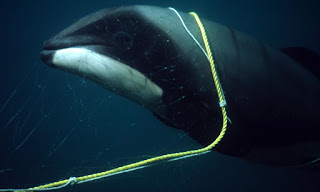Hello again, welcome back to animals under threat. Today,
we will be covering a species of dolphin that is classed as one of the smallest
dolphin species in the world. Please give a warm welcome to Hector's Dolphin
(Cephalorhynchus hectori).
Hector’s dolphin belongs to the Genus
Cephalorhynchus which
consist of four species which are Hector’s dolphin, Heaviside's dolphin, Chilean
dolphin and Commerson's dolphin. They have the most restricted distribution of
any dolphin, whale or porpoise species and resided in the waters around New
Zealand. They are characterized by their colouration with the back/sides been a
light grey, dorsal fin/flippers/ and flukes are black, throat and belly are
white and black crescent shaped band across the head behind the blowhole (Reeves
et al, 2013).
Picture
by James Shook and map by Rudolph
Hector’s dolphin has a unique shaped dorsal fin as it is
rounded compared to regular dolphin dorsal fin are curved. They feed mostly on
fish such as yellow-eyed mullet, sprat and pilchard but also feed on squid if
available (Miller et al, 2013). Hector’s dolphins live in small pods that
contain 7-8 members (Brager, 1999).
Pictures of
Hector’s dolphin with pod mate in background and caught in net by Stephen Dawson / WWF-Canon.
Hector’s
dolphin is under threat from gillnets, pollution, collisions with boats,
habitat modification and diseases. Majority of the dolphins are dying from
drowning by net entanglement as they are unable to free themselves from the
nets (Reeves et al, 2013). Coast development, oil/gas exploration and sand
mining are causing changes in the dolphin’s habitat leading to pollution
entering the water and making the dolphin’s sick (Worldwildlife, 2019). Toxoplasma
gondii is a disease that caused by a parasitic one-celled eukaryote which can
cause Toxoplasmosis. This can affect the dolphin’s body condition and can lead
to death (Roe et al, 2013).
Next time, we will be covering a mouse species from
Australia and its species name is Latin for Smoky.
References
Brager, S. 1999, "Association patterns in three
populations of Hector's dolphin, Cephalorhynchus hectori", Canadian
journal of zoology, vol. 77, no. 1, pp. 13-18.
Miller, E., Lalas, C., Dawson, S., Ratz, H. &
Slooten, E. 2013;2012;, "Hector's dolphin diet: The species, sizes and
relative importance of prey eaten by Cephalorhynchus hectori, investigated
using stomach content analysis", Marine Mammal Science, vol. 29, no. 4,
pp. 606-628.
Reeves, R.R., Dawson, S.M., Jefferson, T.A., Karczmarski,
L., Laidre, K., O’Corry-Crowe, G., Rojas-Bracho, L., Secchi, E.R., Slooten, E.,
Smith, B.D., Wang, J.Y. & Zhou, K. 2013.
Roe, W.D., Howe, L., Baker, E.J., Burrows, L. &
Hunter, S.A. 2013, "An atypical genotype of Toxoplasma gondii as a cause
of mortality in Hector's dolphins (Cephalorhynchus hectori)", Veterinary
Parasitology, vol. 192, no. 1-3, pp. 67-74.
https://www.worldwildlife.org/species/hector-s-dolphin
retrieved 17/08/2019
Picture reference
https://www.iucnredlist.org/species/4162/44199757
https://en.wikipedia.org/wiki/Hector%27s_dolphin




No comments:
Post a Comment